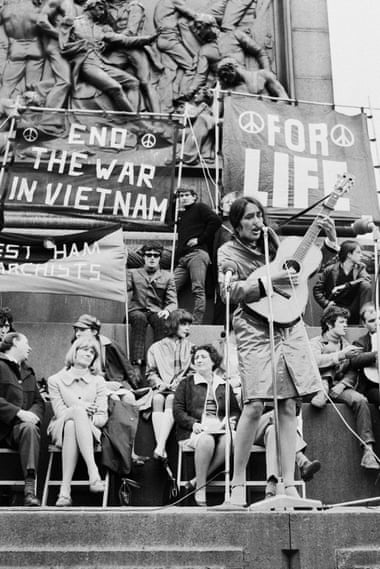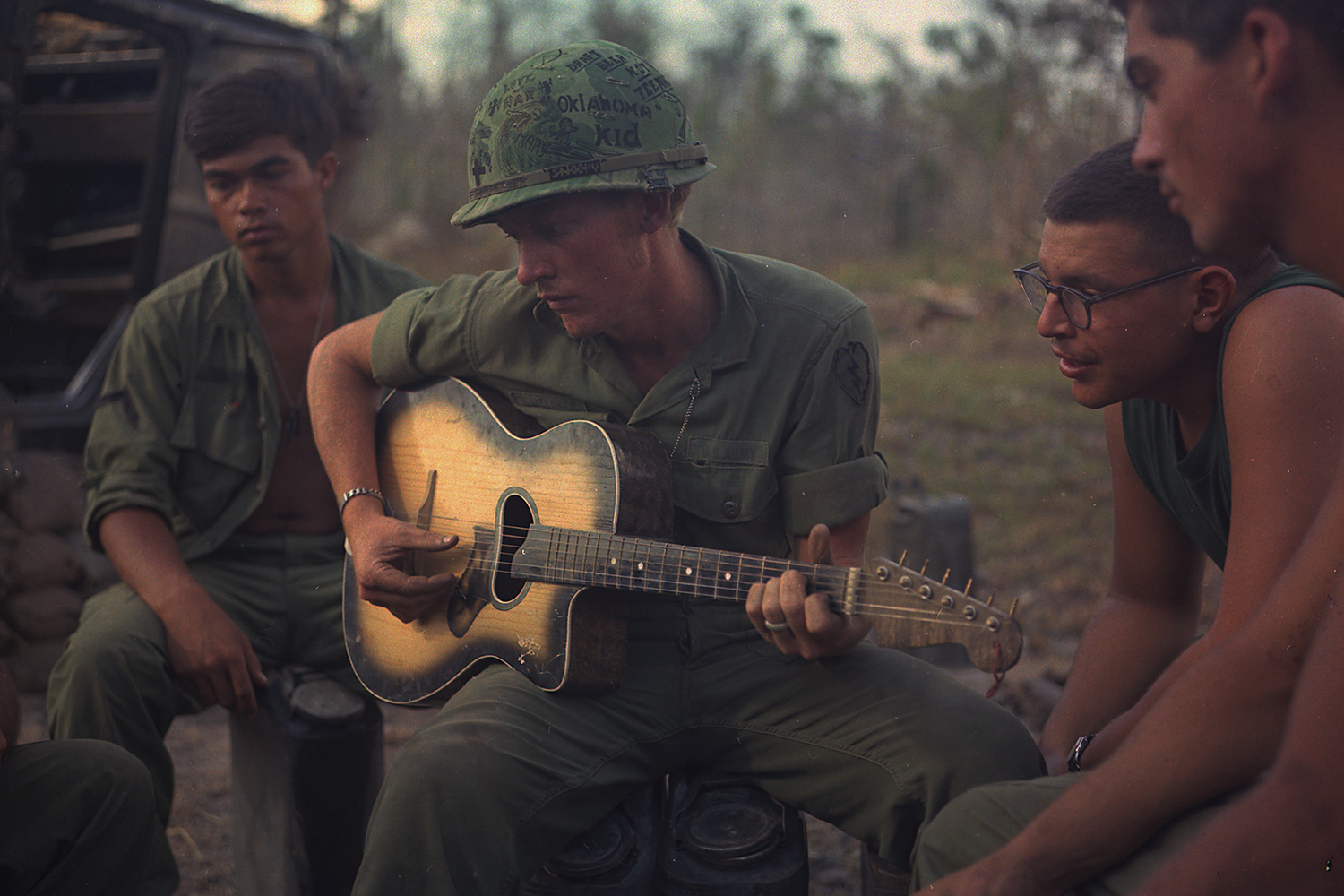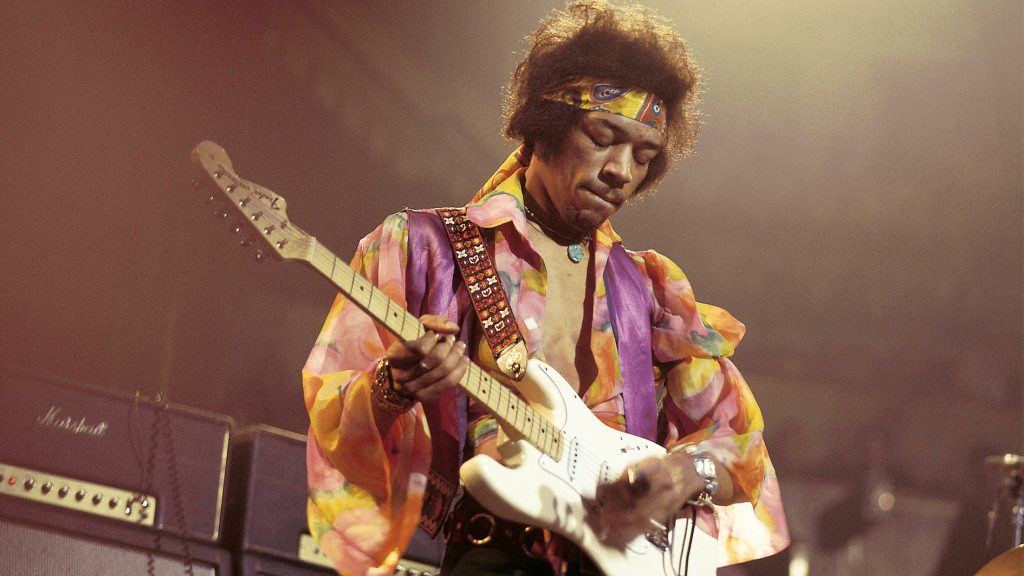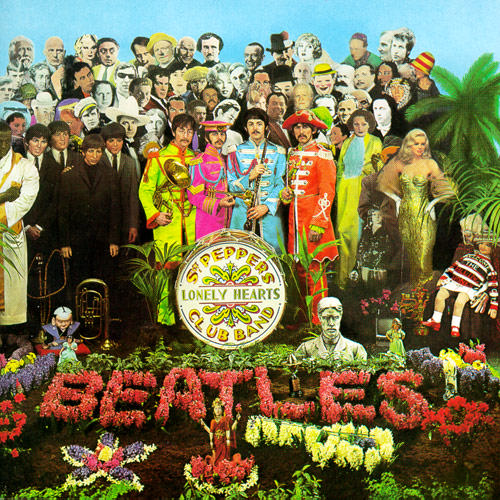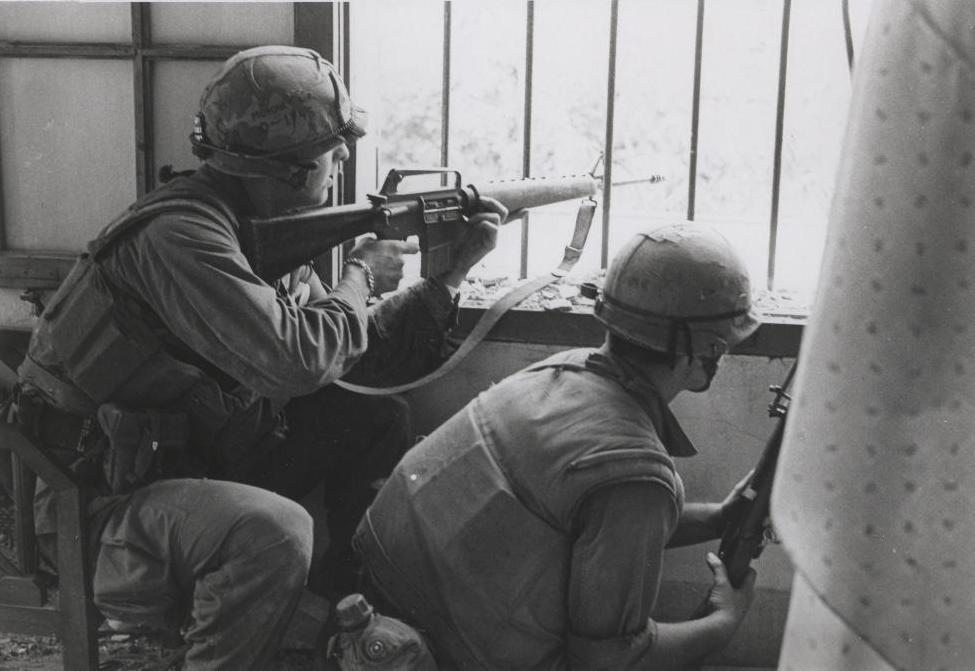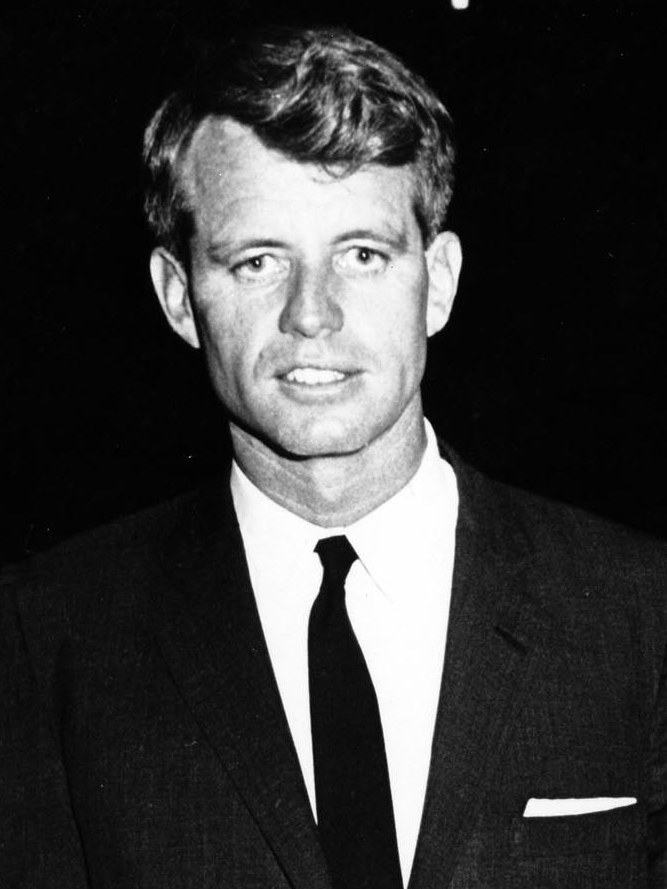By: Sean Riley
(Meisenzahl and Peace, Peacehistory-USFP.org, 2017)
Right: US Soldier playing guitar in Vietnam for his fellow servicemen. (Operation Yellowstone, January 18, 1968)
(Brummer, HistoryToday, 2018)
Introduction:
During the 1950s, American culture was forever transformed when the music genres of blues, country, folk, and gospel blended together into a new style of music called rock & roll. This new genre not only created a new sound that was overwhelmingly popular with America’s youth, but also caused a rift in American societal norms deemed essential to American conservatives and Christians.
By the 1960s, rock & roll had already gone through its first wave of influence by bridging certain gaps between white and black cultures, all while exploring new views of sexuality and the teenage identity. In 1964 America was forever changed when the Beatles started a British musical invasion of the United States which brought British Rock & Roll into the American mainstream. The 1960s would also see the revival of American folk and blues which gave the American troubled youth a voice and new identity. Throughout the 1960s and 1970s, music produced by American and British performers became the anthems of the countercultural movements as artists sang about freedom, love, equality, antiwar, peace, sex, drugs, and cultural revolution. The music of these two decades helped transition millions of teenage Americans away from the cultural normalities of their parents and into the countercultural movements of the Vietnam Era.
Narrators:
Rob and Tim are two brothers who were born during the 1950s and grew up in working-class America. Tim, the oldest of the three, was born in 1951 in Perry, Iowa. Rob, the middle child, was born in 1956 in Sewickley, Pennsylvania. Both of them grew up in California until their parents relocated back to Iowa. Tim served in Vietnam from 1969 to 1973 and Rob served in the US Navy shortly after the end of the Vietnam War in 1975, after joining on the Delayed Entry Program (DEP). Throughout their interviews, both Rob and Tim told of their life stories while stating the tremendous level of influence that new music had on them, their family, and their entire generation. Rob grew up listening to rock & roll, rhythm & blues, folk and blues. Tim liked rock & roll and folk as well but stated that he had a deep passion for Gospel, Motown, and classical music.
The Beatles and the British Invasion:
Throughout the 1960s, there were many musical revolutions and revivals, but none were more impactful to the United States and its culture than the Beatles and the subsequent British Invasion. The Beatles were a musical group from Liverpool, England. Their band consisted of four artists, John Lennon, Paul McCartney, George Harrison, and Ringo Starr. The band mirrored the layout of 1950s rock & roll bands, especially that of Buddy Holly and the Crickets, having a lead, rhythm, bass, and drums. The Beatles were originally successful in Britain before their song, “I Want to Hold Your Hand”, crossed over the Atlantic and topped the US charts in January 1964. Finally, on February 7th, 1964, the Beatles landed in America, and on February 9th, they performed live on the famous American television show, The Ed Sullivan Show. Rob and Tim were two of the over seventy-four million people who tuned into The Ed Sullivan Show to watch the Beatles perform live. Like millions of other Americans, Rob and Tim were starstruck by the Beatles and their music. Tim stated, “It was a big deal. Huge!” He later mentioned in the interview,
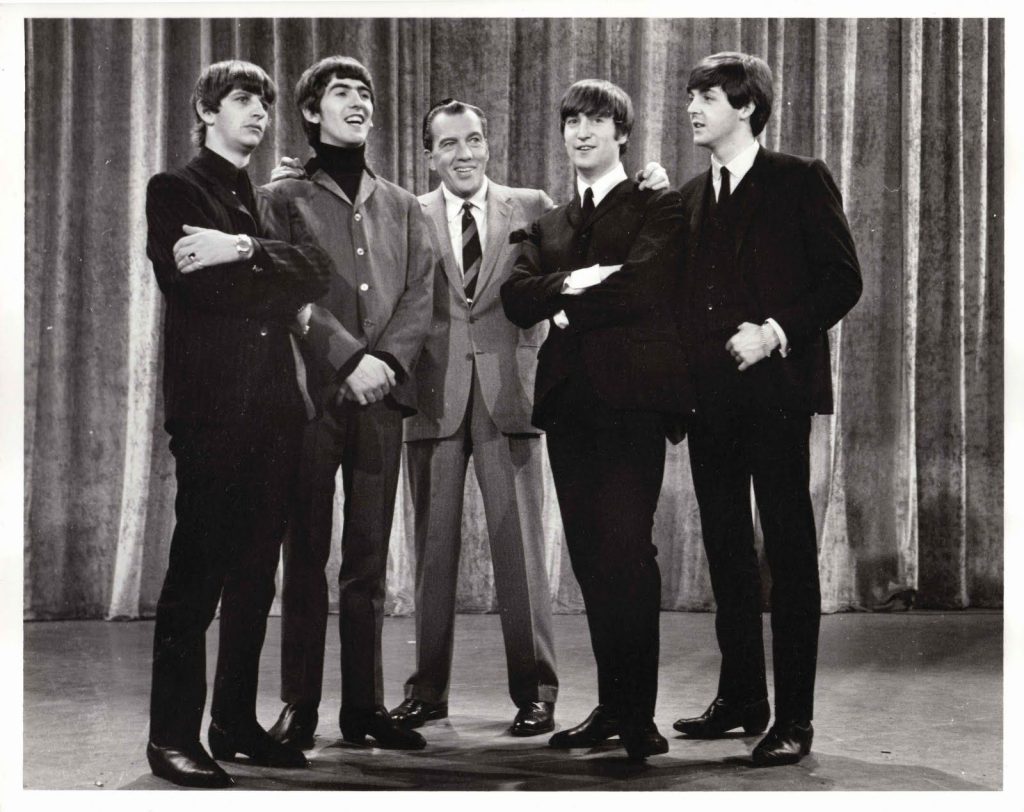
(IMDB, 2021)
“Yeah, it was mindboggling! It was like, “Wow, look at these guys!” You know, cuz I’d never seen anything like that before. They were it and they were new. They were new and fresh. And to guys like me, who had just been listening to the ’50s more or less because I heard it. I wasn’t into the music that much, but I knew these guys were different and the music was like, “Whoa!” And of course the whole thing, everybody was getting hip to the Beatles like, “Wow, this is cool.” Even if you didn’t know much about music, you just gravitated towards it because everybody else was.”
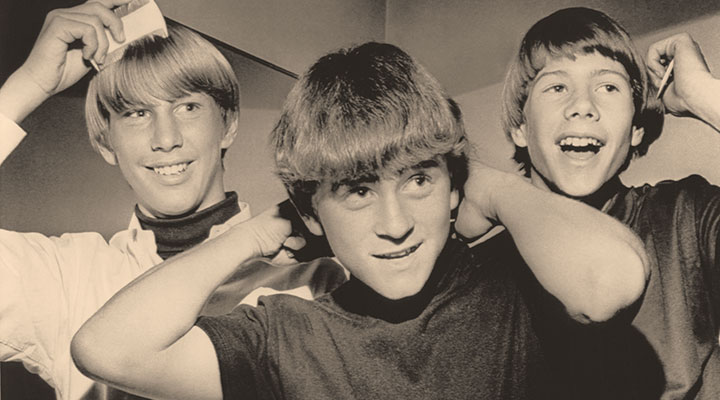
San Diego, CA, November 9, 1965. (Underwood Archives)
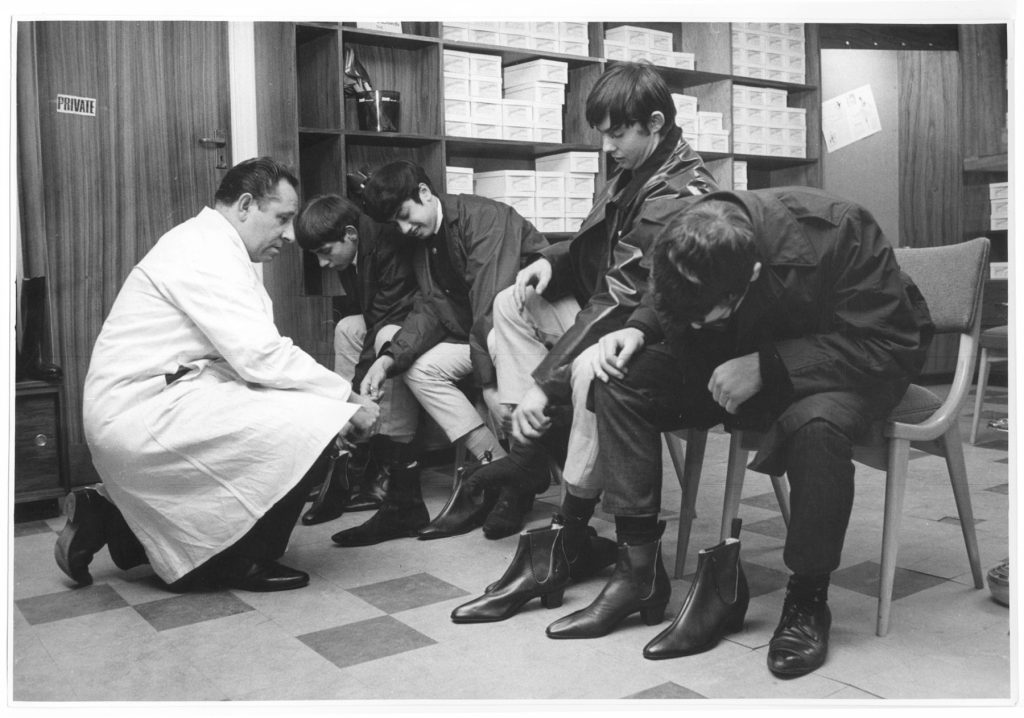
As Tim expressed, the Beatles’ live performance on The Ed Sullivan Show continued the Beatles’ fame and popularity in America as America’s youth were drawn further into their music and their culture. Rob, who stated that the Beatles on The Ed Sullivan Show introduced him to music, explained how the Beatles impacted America’s youth culture not only in music but in fashion and entertainment. He said that after The Ed Sullivan Show, “Everybody right away wanted to be like the Beatles, you know, grow their hair, grow bangs, and everybody wanted Beatle boots. They all wore Beatle boots.” The Beatles started a cultural revolution among America’s youth. Teenage boys throughout America, starting predominantly on the east and west coasts, began growing out their hair to resemble the Beatles in contrast to the short, military hairstyles that were a societal standard for men prior to this cultural revolution.
The success of the Beatles in America sent a tidal wave of British performers to American soil and, subsequently, to the top of the Billboard charts. Tim recalled this transition, “Whoom, the British Invasion was on. And here they come, The Stones and The Yardbirds, and all the rest of those guys. They started coming to America. They knew America was a massive market.” The British Invasion further influenced Rob, Tim, and millions of other teenage Americans as teens wanted to listen to this music, dress like the performers, collect their records, and play their music. Rob and Tim recalled one of the largest influences that music had on their lives while growing up in California was the Garage Band scene around Los Angeles. Most of these amateur bands would host parties and mimic the music of the Beatles and other hit artists. Rob and Tim attended these parties while growing up in Los Angeles. Rob explained, “[The bands were] trying to play the Beatles music. Everybody had their garage, and one guy had his garage painted all black and a lot of blacklight posters with blacklight painting everywhere. And then he had a drum set. And guys were trying to get together and play music together, try and play like the Beatles, you know, and The Stones and try and be like that, express that.”
Backlash to Cultural Change:
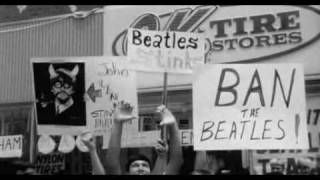
(SgtDavid16, YouTube, 2010)
Though millions of teenage Americans were transformed by The Beatles, The Rolling Stones, Herman’s Hermits, The Dave Clark Five, The Kinks, The Animals, The Hollies, The Yardbirds, The Who, and many more, the music revolution of the early 1960s was not perceived well by every American. The British Invasion, similar to previous music revolutions, took longer to influence certain people. For example, Tim and Rob stated that Iowa and the Midwest were culturally behind California. As Rob put it, “Iowa was behind California culturally, it seemed like about five years.” Later mentioning, “Yeah, everything. Culture, haircuts. Yeah, music. Maybe that was just where I lived or who I was around. I don’t know. Seemed to be more like Leave It to Beaver. Like old-fashioned, really.” Tim mentioned the same thing when he returned to Perry, Iowa from California in the summers during the 1960s, “[Back] then things started on east and west coast, whether it was music or style, or dress or hair, and it moves slowly to the Midwest. So when I would come from California to Iowa in the summers in the ’60s, I would literally go from major metropolitan Los Angeles to basically moving to Mayberry for the summer, because Perry was in the middle of the country, and in Iowa, most pop culture was a little behind.”
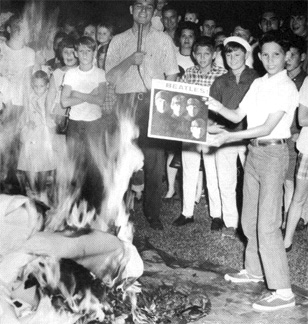
(United Press International, August 1966)
The American Midwest and the American South tended to be more hostile towards the radical changes brought upon by rock & roll throughout the 1950s, 1960s, and 1970s. During the 1960s and 1970s, conservative Christians attacked rock & roll and the music revolutions as they believed it was dissolving America’s morality and civilization. According to author Randall J. Stephens in The Devil’s Music (2018), the tight clothes, long hair, and actions of the Beatles were believed by many conservative Christians to be leading America’s youth towards perdition. Conservative Christians feared that the musical, and subsequent social and countercultural, revolutions of the 1960s were destroying American society and the Christian faith, a belief proven true in the minds of many Christians when John Lennon commented in 1966 that the Beatles were more popular than Jesus. Many parents feared that their children were being led down the wrong path by music and the culture surrounding them. As Tim mentioned, “Most of the parents of the friends that I had, were [from] the World War Two generation who were just a little bit concerned. They didn’t like the way that music was going. It was changing for them too much. It was a radical change from [the] Big Band to 10 years of the 50s rock, and then this thing happened.” He later continued, “Because none of us experienced anything that radical. We’ve seen change, like hip-hop music and all that, but not like what they experienced.”
Both Tim and Rob recalled how their parents reacted to the Beatles and radical change in youth culture. Rob explained,
“I think The Beatles went over pretty good with my mom, just because they were cute. And it was pop, real poppy, but it wasn’t long after that when all the other bands came around and I think that sort of frightened the older generation. Because it was totally different rhythms and a lot louder and everything wasn’t exactly how it always had been. The instruments were different. And like I said, everybody grew their hair out and they started to sing about the things young people were concerned about, like freedom and peace and love.”
Tim and Rob both had personal experiences where their father reacted negatively to the music they were listening to. Rob recalled when he was listening to the Pink Floyd psychedelic album, Ummagumma (1969), while living with his parents in Iowa, and his dad heard the album being played in the other room. According to Rob,
“Anyway, my dad came and I was on my record player, and he came in and I could see he was scared. And he came in, took the record off, and broke it in half in front of me. Yeah, he’s never done anything like that before. After that, I moved upstairs and I was staying upstairs. That was better because we could play music and because otherwise [minor interruption], I was in that room downstairs where RJ and Sandy’s [younger brother and sister-in-law] bedroom that was where I had a bedroom. I moved upstairs because of more independence. My dad literally came in and broke that record. I could see he was afraid. Because it was weird, man. I mean, it was just weird, you know, it was even lyrics. It was just sound effects and they had great precautions set up. And so it was just a lot of feedback. And one of the names of the songs was “Careful With That Axe Eugene.” And the other one was “Several Species of Small Furry Animals Grooving Together in a Cave with a Pict.” So I remember that and that album scared my dad.”
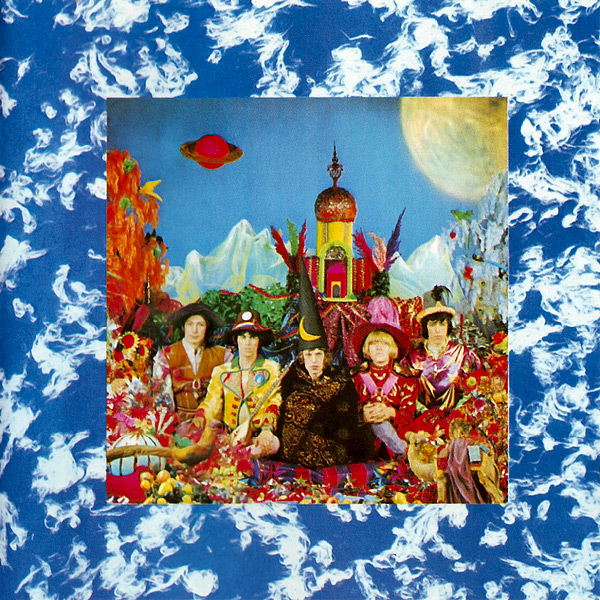
(Landau, Rolling Stone)
The fear from the psychedelic sounds coming from the music of the late 1960s led Rob and Tim’s father to take action and break the record so that Rob could not listen to it. Like Rob, Tim too had a similar experience when their father heard Tim listening to The Rolling Stones album, Their Satanic Majesties Request (1967). Tim stated, “A matter of fact, I had told Robbie the other day that I remember buying an album. I think it was [Their] Satanic Majesties Request by The Rolling Stones. And you know, the album cover is even pretty exotic. And when I played that record, my dad literally threw it out of the house. He didn’t want that in his house. That music was just, “nuh-uh.” So he had me banned from playing that record.”
Their father not only feared the music but the culture around it. By the late 1960s, American rock & roll music transformed once again, forming two different types of rock & roll. The first new type of rock & roll was psychedelic rock. Psychedelic rock is a type of rock & roll that blends loud, exotic, unique sounds with references to drugs and their effects. This type of sub-genre became popular with many teenage Americans around 1966. Some of the most notable artists who performed psychedelic rock were Jimi Hendrix, The Beatles, Jefferson Airplane, and The Rolling Stones. The mixture of music and drugs like LSD, psychedelic mushrooms, and marijuana influenced many teenagers to experiment with these types of drugs, increasing the fear of societal collapse and youth downfall in many parents and conservative Christians. According to a Gallop poll that began in 1967 and traced college marijuana usage throughout fifty-seven college campuses, marijuana usage was rising in many colleges. The largest increase in marijuana usage was in San Francisco in 1968 where ⅓ of women and ½ of men who were surveyed claimed they had tried marijuana. The increase in marijuana usage among American teens alarmed parents, including Tim and Rob’s father. Tim recalled an experience where his father came into the house and talked to Tim about drug usage. He said, “A matter of fact, I remember my dad bringing home two joints, marijuana cigarettes, right? And laid them on top of the refrigerator. He brought them in the house one night after work and said, “These are marijuana cigarettes. You don’t ever smoke these!” And he laid them on top of the refrigerator, just left them there for a minute or whatever. But he was exposing us, showing us because he was not familiar with it. That generation wasn’t. And so he was just making us aware. “This is marijuana. It’s bad.”
Tim went on to say that he believes that his parents saw the rapidly changing culture in California and how it was impacting the behavior of their children, which is partially why Tim believes they moved back to small town, rural Iowa. He stated,
“So they came back in ‘70, brought my younger brothers out of California. That’s another thing that rock & roll did you might say. It was such craziness in Los Angeles after The Beatles were exposed to America, and we saw the pop culture change and the rock & roll thing change and the drug thing changed. It was changing fast. The sexual thing, loose sex was never talked about much. It was maybe, you had a bad reputation, but now it became almost cultural to be more openly sexual about your feelings and how you want to act. Well, my parents saw the unraveling of, [what] they thought, society in LA because of all this stuff going on, rock & roll and sex, drugs, and this and that. And it was increasing. Some activity wasn’t necessarily good. Some of it was, you might say, crime being on the peripheral of the music. So my parents saw that and I had younger brothers, two younger brothers, my parents didn’t want them to live in that environment anymore. So they moved back to Iowa, to take him back to Mayberry. So they would have a chance to live a life without having that kind of craziness. And they saw me, the oldest brother, [in] some trouble with the law and trouble with drugs. And my parents didn’t want my brothers exposed to that.”
As aforementioned, American teens were being exposed to a new form of teenage culture that was unique to the teenage identity and young adults as it differed greatly from the traditionalism of earlier generations. Some parents, like Tim and Rob’s, saw this and feared the worst for their children, which is why Tim believes they moved back to rural Iowa.
Psychedelic Rock:
(Redfern, Davidredfern.com, 2013)
Right: The Beatles’ Sgt. Pepper’s Lonely Hearts Club Band album cover, 1967.
(Robert Wade, Flickr, 2009)
Tim and Rob both mentioned that the psychedelic era influenced them at a very young age. Rob claimed that he was influenced by psychedelic art, painting, and music. He said this when asked about the psychedelic era, “Oh, yeah, yeah, because I’d say art, especially. I liked art in school. So I think the psychedelic movement influenced my idea of what I thought was really good art and painting and the music and then clothing. And I think it was a freedom of expression that had never been done before. And I think that psychedelia opened that up.” When asked a similar question about the psychedelic movement, Tim answered, “Yeah. It impacted my life a lot because I think I was starting to listen more to music then too because it made my ears grow like, “Oh I want to hear this.” Because it was different and new. And that was all part of that rock & roll, psychedelic movement. Because there was a lot of big things happening.”
Music and Counterculture:
Though Rob and Tim both state they were influenced by psychedelic rock in many ways, a larger influence to them was the second type of music to emerge within rock & roll and many other music genres during the 1960s, countercultural music with a message. Tim calls this music “message music” as it was music with a message about the current times. Psychedelic rock indeed branched over to this style of music, for example, Jimi Hendrix’s “Machine Gun”, but it was also prominent in regular rock & roll, folk, Motown, and rhythm & blues.
The late 1960s and early 1970s were periods of global change and global chaos. The Cold War had been raging for over two decades, nations were involved in national and civil wars, and the United States continued to face issues both domestically and abroad. America’s youth saw and personally experienced the growing tensions at home and around the world. The message music of the era became the anthems of countercultural protests, demonstrations, and the American teenage identity. In reality, events occurring in America, as well as the countercultural movement itself, influenced music just as much as music influenced it. It was a tremendous snowball effect which can best be seen through the movements and music of the middle to late 1960s.
Middle: US Marines during the Battle of Hue, February 1968. (Jonathan Abel Collection, Flickr)
Right: Senator Robert F. Kennedy. (Kheel Center, 2010)
1968 was a year full of cataclysmic events. Revolutionary movements were taking place around the world as oppressed people fought for their ideologies and freedoms. In Vietnam, the Viet Cong (VC) and North Vietnamese Army (NVA) launched the Tet Offensive early that year, inflicting heavy casualties on American and South Vietnamese forces. In America, popular support for the war continued to plummet as news of US atrocities reached American newspapers, radios, and televisions. The American people quickly found out that US politicians and military leaders had been lying to them about the status of the North Vietnamese Military and the war itself, and began to see no clear end to the war. 1968 also brought a spike in antiwar protests, as well as the assassinations of Reverend Martin Luther King Jr. (April 4) and Senator Robert F. Kennedy (June 5). The performers of this era used musical lyrics to express frustration and distress over certain domestic and international issues which, in turn, influenced how many people perceived the events unraveling around them. By 1968, antiwar songs were less satirical and more direct, pushing feelings of anger to an audience who looked up to these musical activists. Both Rob and Tim were caught in this exact snowball effect because the music that they listened to, the culture that they were exposed to, and the events that they experienced all influenced their opinions on issues such as civil rights and the war in Vietnam.
(PettyYou007, YouTube, 2010)
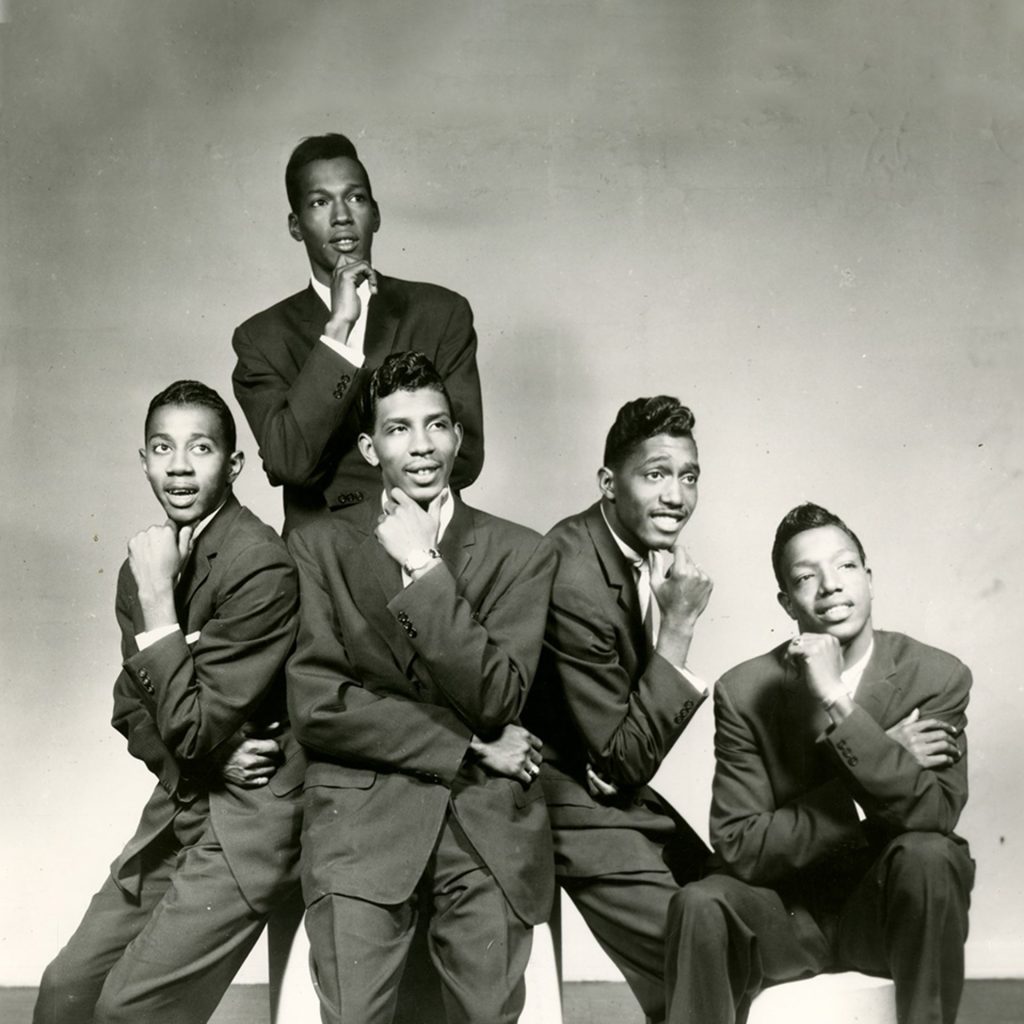
Tim remembered the antiwar protests in Los Angeles and the music that followed. According to Tim, “That [antiwar protests] was happening already in the Los Angeles area. There were war protests starting. And then of course, the music movement. You had Buffalo Springfield coming along, you know, and their music, and those famous artists in that band, and other bands, protest songs. And of course, the folk singers were also into that. So yeah, I saw some of that in Los Angeles in the late ’60s, before I went to Vietnam. They were already protesting in Los Angeles.” During the interview, Tim placed an emphasis on one of his favorite genres of music, Motown. Motown Records was established by Berry Gordy Jr. in 1960 in Detroit, Michigan. Its rhythm & blues had such a unique sound as Berry Gordy hired professional jazz players to back the singers. This unique sound became known as the “Motown Sound”. Berry Gordy and Motown Records introduced Americans to a phenomenal lineup of legendary singers including Marvin Gaye, Stevie Wonder, The Temptations, The Miracles, The Supremes, and much more.
The Motown sound and its phenomenal musicians were not only anthems to the antiwar movement, but also helped bridge the racial divide as white Americans listened to and were influenced by the music genre established and performed by African American artists. According to Tim, both the British Invasion and Motown led him and his peers to reconsider what was happening around them. He stated,
“And I think the greater culture, the greater questioning of everything that all [of the] sudden [was] like, “Wait a minute, what are these guys in Washington doing?” You know, “What is this all about?” Music opened our eyes to that because of the lyrics that we heard. We’re hearing those messages, these young, progressive musical talent. And again Motown too, they were doing the same thing. But it was happening and people were hearing it. It was there, was going on, it wasn’t any way you were going to stop it. And even though my dad didn’t want that record in the house. Those records were everywhere.”
(Stream Crops, YouTube, 2007)
He also mentioned that the Motown sound brought people together as it produced songs advocating against the war in Vietnam. “-there was another artist that wrote the song, “War.” That was a Motown song. That came out of the Motown label. “War,” good golly, “What is it good for? Absolutely nothing!” That was a Motown song. That was definitely against the war. And when black and white boys were both going to Vietnam, they weren’t picking colors. Not by then, we were all going. Everybody together.” Edwin Starr’s song, “War” (1970), was one of the many Motown hits that pushed antiwar sentiments to its listeners. As Tim stated, men, regardless of race, were drafted to Vietnam. African Americans played a significant role in the Vietnam War with many serving in combat units. The Motown hits reflected the suffering and frustration of these men going to war and the families they were leaving behind.
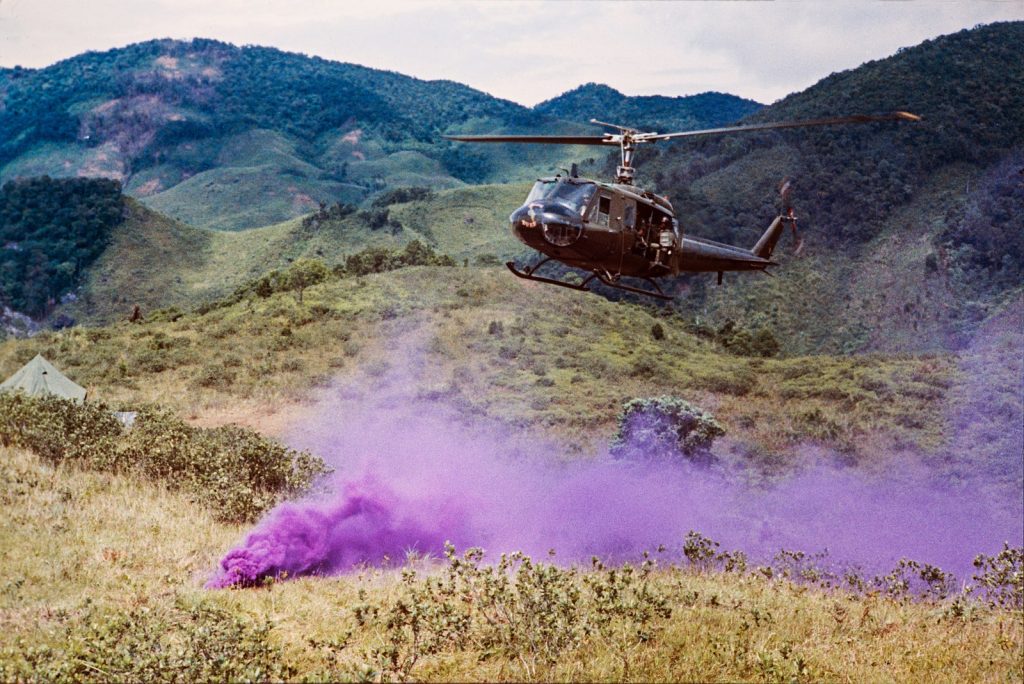
(National Archives Catalog, 1967)
American music, and the antiwar sentiments produced in it, found its way to Vietnam as soldiers listened to the same musical hits that were broadcasted throughout America. Some famous hits had deep meanings to soldiers. For example, Jimi Hendrix’s “Purple Haze” was sometimes associated with an LSD trip, but to soldiers in Vietnam, this song was associated with the purple-colored smoke grenades used for guiding helicopters. Tim recalled a few songs that he and his fellow soldiers listened to while serving in Vietnam from 1969 to 1973,
“Jimi Hendrix, you know, The Doors. Mostly rock & roll and some Motown. Because you know, there weren’t too many black guys where I was at, in my units, but still, everybody liked Motown. Smokey Robinson, The Miracles, The Temptations, good music. I mean, really good music. And I listened to a lot of it. So I enjoyed that. Yeah, I enjoyed Motown, and more psychedelic rock, you might say. Jimmy Hendrix, The Doors, you know. Yeah, all of us were listening to that, I mean, that’s what we had. And there was still some leftover ’50s music that was still cool.”
I later asked him if he remembered listening to any antiwar music while serving in Vietnam to which he replied,
“Yeah, I would imagine not that I specifically remember, but I would imagine I heard some that was going on because a lot of the music was becoming protest music. And again with the folk music. We knew about Bob Dylan and Joan Baez and those people. They were doing it, and yeah, we heard that too. So we were listening to that. We were hearing that music, and it was making us think about it. But most of us, you got to remember, were 18, 19, 20. We really didn’t understand as much as maybe some of the older guys might’ve about why are we in Vietnam. “I’m only here because I got drafted.” You know, kind of thing. But the music was starting to open people’s eyes. But we weren’t able, I don’t think, to express it to each other, how we were feeling. We just knew that [we] wanted our ass out of there. Well, personally. “I just want to go home. I don’t want to be here anymore!” (Laughing)
“It was kind of an interesting time. But yeah, the music was impacting us enough that we were thinking about it. But I don’t think we’re talking about it as much, then. That was in, remember, [the] late ‘60s and early ‘70s. But it was starting to change us. Oh, it was, it was changing us. We were starting to think less inclined, “Why are we here?” We started questioning the Kennedy assassination. Us young guys wondered, “Did that get us here?” “We part of that here?” We’re trying to connect the dots. And the music was helping, of course, because of the messages in the music again. There was message music and mood music. You know, rock & roll had a little bit of both.”
(The Ed Sullivan Show, YouTube, 2021)
As Tim mentioned, there were popular hits that he remembers listening to in Vietnam, but not every song broadcasted was antiwar. The radios played a mixture of psychedelic rock, Motown, folk, and rock & roll. That being said, antiwar music still reached soldiers in Vietnam. As Tim stated, the antiwar sentiments in the lyrics of certain songs began to change some soldiers as soldiers began questioning why they were there, but overall, the concern of Tim and other soldiers was getting back home in one piece. This corresponds with Kim Herzinger’s chapter The soundtrack of Vietnam in America and the Vietnam War (2009) in which she states that soldiers did listen to music regarding the Vietnam War, but most soldiers loved “going home” or “leaving” songs like “We Gotta Get Out of This Place” (The Animals, 1965) as they expressed the soldiers’ desire of going back home to America.
Rob too served in the United States military, but he entered the US Navy after Vietnam in 1975. The counterculture music of the Vietnam Era had a slightly different impact on Rob compared to Tim. Rob remembered his experience with the counterculture movement, mainly the antiwar movement. He mentioned how counterculture music and its message spread so easily to America’s youth population. Rob explained,
(Neilyoungchannel, YouTube, 2017)
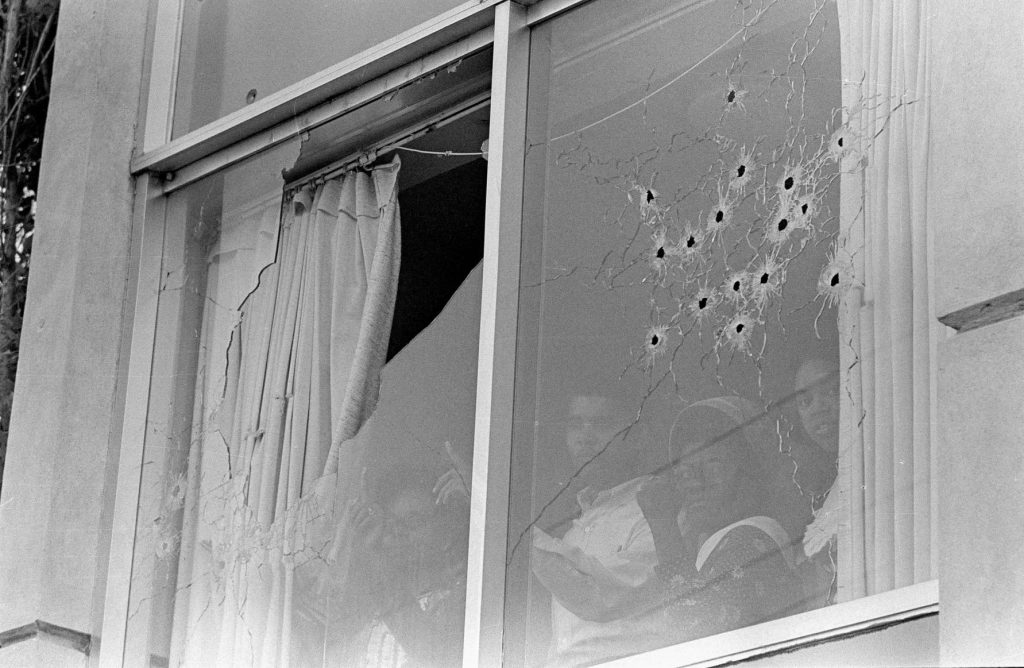
(AP Photo, Crawford, 2020)
“Yeah, because even on the radio, a lot of stuff was getting airplay. A really big song was when Neil Young wrote for Crosby, Stills, Nash and Young was “Ohio”. That was big about the Kent State killing, and they played that. And that was on the radio, and that got to be a big hit. And so everybody knew what that was all about because there was a big shooting and they killed people at Jackson State which didn’t make as much news, but it happened at the same time as Kent State. And then obviously, the song about the Chicago Convention, ‘68, was also by that band. And that was Buffalo Springfield, Neil Young, who wrote that and he was an activist. So a lot of this stuff was commercially successful. So people were drawn to that and then the message of that, and then every night on the news, Vietnam, you know, and people going to Vietnam and going to the military and then some people not coming back.”
“It was rock & roll and folk music and soul music, r&b, you know, so everybody was talking about it. You know, there was even a band called War, and that was like an r&b, rock & roll band. There were a lot of music that was antiwar, pro-peace, you know, obviously “Revolution” by the Beatles. I mean, I can go on and on. Well, the kids were listening to all that. A lot of times music concerts would bring up about stopping the war or even mentioning that this is not right, and we need to change and not become a police state. That’s what everybody was afraid of.”
“I think that started to draw the youth. And then, as more people were killed in Vietnam, and Vietnam dragged on, and went into the ‘70s. There was more coalitions of people that were drawn to the antiwar movement. You know, the old adage is, the hardhats versus the hippies. Well, eventually, the hardhats started getting drafted too. So they started uniting with the kids and the antiwar movement got so big that, you know, it eventually stopped the war. That’s my opinion. Because it’s just a moneymaker, you know, a meat machine.”
One of Rob’s personal experiences at an antiwar protest occurred in Iowa City in May of 1972. Rob said,
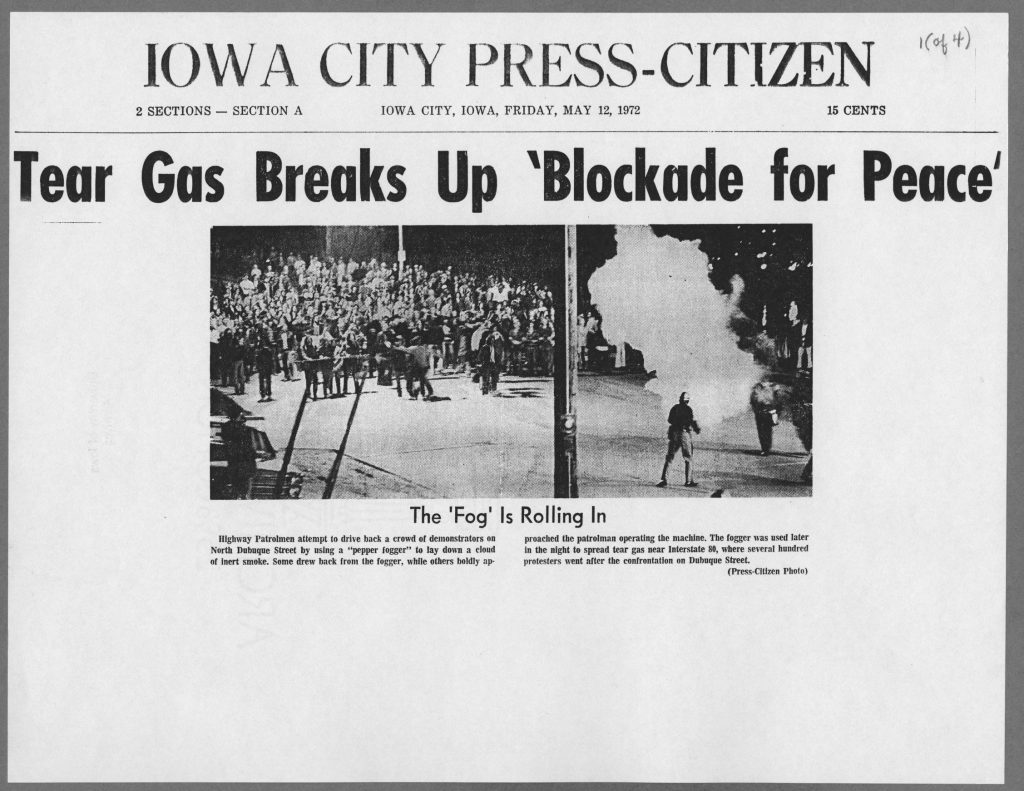
(Iowa City Press-Citizen, University of Iowa, May 12, 1972)
“We got caught up in [the protest] randomly that I didn’t know about ahead of time. I just kind of ran into it, in downtown Iowa City, the Old Capitol. And that made the news probably. I’m sure it made the news because it was big. There were a lot of people there. A lot of students, it was all kids. And a lot of cops it seemed like. Maybe there was more. Maybe there wasn’t so many cops, maybe it was just [that] they were loud. They had bullhorns and tear gas. We got tear-gassed.”
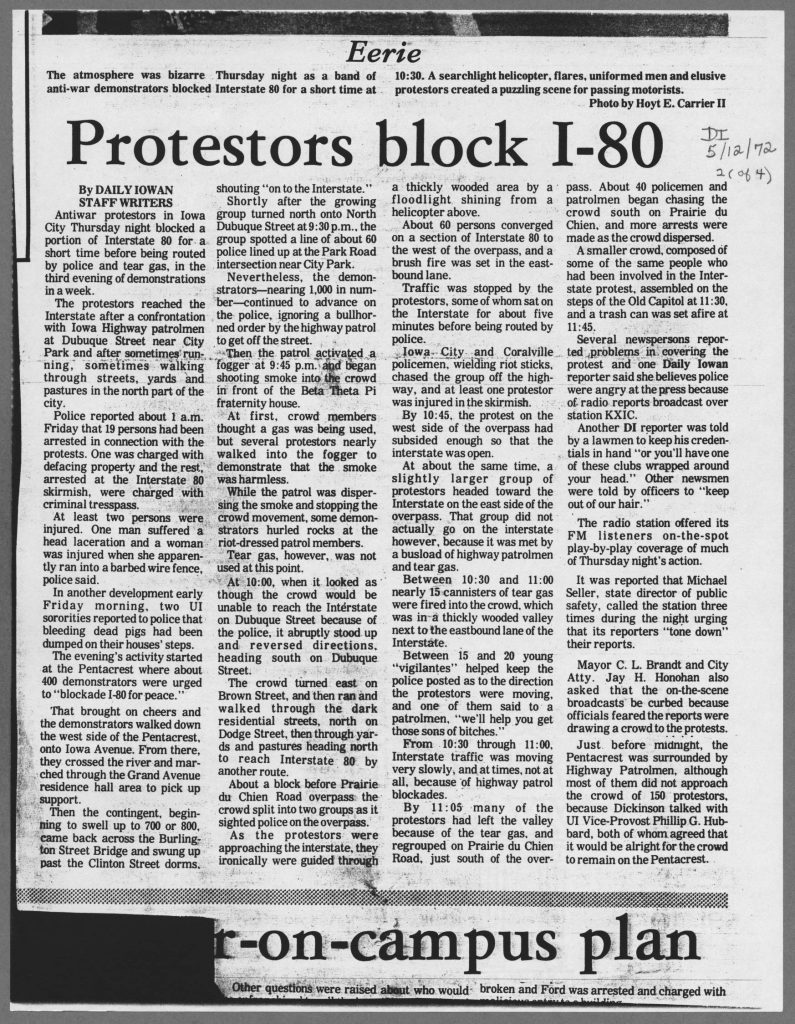
Iowa City Protest
(Daily Iowan, University of Iowa, May 11, 1972)
“It was a peaceful gathering and they were saying that people were going to cause damage. I learned this later, and the cops tried to push everybody in a certain direction. And there were so many people and so much miscommunication. There were speakers there. And people were talking about protesting the war. And I think the cops tried to get everybody off the street and tried to make it look like it was vandalism and stuff when it really wasn’t. The only problem happened in the chaos of the cops herding everybody away, then probably people started throwing things and doing things because they’re pissed off. But people got tear-gassed and it forced everybody to go in different directions, which some people probably fell down and got ran over. Because it was so full of people. If you’ve ever been in that area, you know, there’s buildings and there’s not a lot of places to go once you’re crowded in there. And so, yeah, and I was worried that I would be in trouble because my parents didn’t know I was in Iowa City that weekend.”
When I asked him if he recalled hearing any music at this protest, he stated,
“Yeah, there were people playing acoustic music but I don’t remember. It was local [music], probably the school, college guys from the school. There were people playing acoustic guitar. That’s what drew us to that area and that’s where the Old Capitol is, not in front of the old capitol, like where the big flag is out front. There’s a couple [of] buildings and the main building, and we’re in front of that. That’s where the big crowd was, and there was music and they had a PA, so you could hear the people playing music, acoustic guitar.”
“It wasn’t like a big mean, protest, it was like a positive get-together. You know, and we were just there to see some music in Iowa City, an organized concert. Turned out this was going on that weekend. So we happened to be in the right place or the wrong place at the right time. I don’t recall the music and it was probably local people. And I think there was some chanting and stuff, and then it didn’t take long before the cops came and the chemical stuff [came] and [the cops] tried to disperse everybody.”
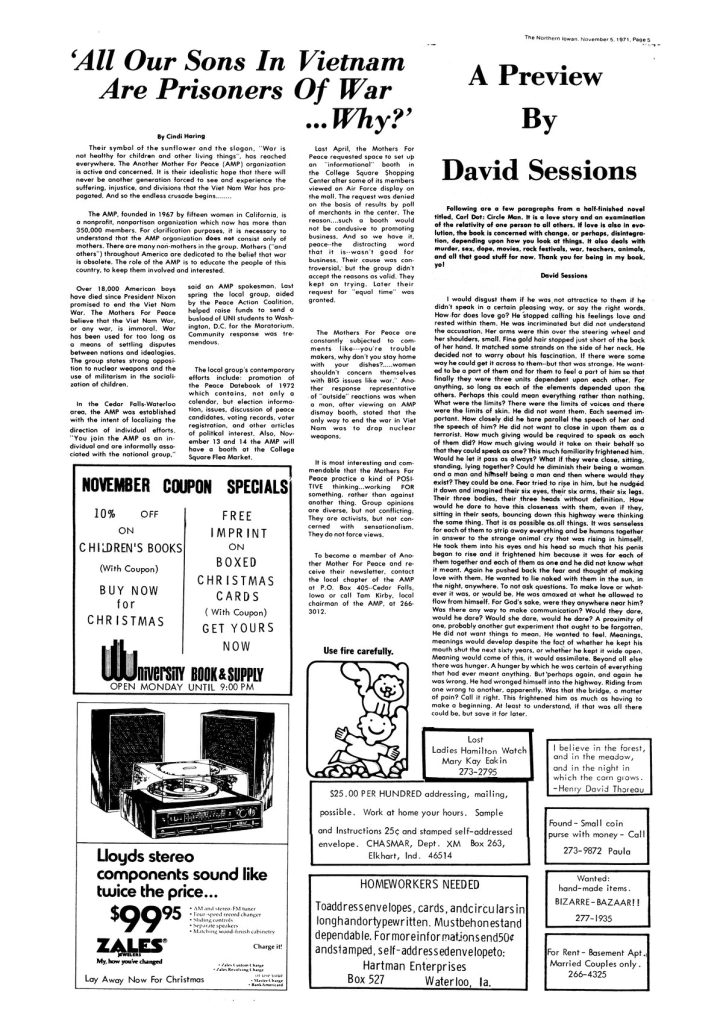
Another Mother for Peace (AMP) Link
(Haring, Northern Iowan, University of Northern Iowa, 1971)
Not only did music bring Rob to Iowa City that weekend, but the sound of music and the sight of a large gathering brought him into the antiwar rally held throughout that second week of May 1972 in Iowa City. Just like Tim, Rob’s perceptions of the world were influenced by the music and culture around him. Songs about the Vietnam War, protests, and massacres were airplayed on the radio, causing Americans like Rob to grow socially discontent with the American Government and its policies. As Rob mentions, by the late 1960s and early 1970s, student-led antiwar protests turned into community-wide protests as coalitions joined together to advocate against the war in Vietnam. Even though the common narrative focuses on parents slandering youth culture, many parents supported the antiwar movement and the music that came with it. Famous groups, such as Another Mother for Peace (AMP), organized with students, community members, and other coalitions to protest against the war in Vietnam. According to Joseph Kotarba’s article Rock ‘n’ Roll Experiences in Middle Age (2005), rock & roll’s links with politics, civil rights, and the antiwar movement meant that its audience was much larger than just America’s youth. Instead, rock & roll’s audience was and still is very diverse, including children, teens, and adults, because the music covered such diverse topics and appealed to so many people. Though this is true, we must remember that this statement is not universal as some parents did not approve of the new music and messages put out by musical artists.
Conclusion:
Overall, the music of the 1960s and 1970s became the anthems of freedom, love, equality, antiwar, peace, sex, drugs, and cultural revolution which, in turn, transitioned millions of teenage Americans away from the cultural normalities of their parents and into the countercultural movements of the Vietnam Era. Events happening both within and outside America impacted musical artists who transformed their sound and the message behind their lyrics. As these songs grew in popularity, they began to influence listeners from around the world, causing some people to experiment with new trends, question the status quo, and advocate for reform in US policy. The change in music and culture, which varied per location, snowballed after one another, causing a tremendous countercultural movement to grow as events throughout the late 1960s and early 1970s worsened. Rob and Tim were two of the millions of Americans who were influenced by this snowball effect.
Though Rob and Tim’s experiences differed, both were impacted by the music of their generation. Tim was impacted by rock & roll, psychedelic rock, and Motown, which he credited for changing everything from how he and his peers dressed to how they perceived the war in Vietnam. As for Rob, he was impacted by rock & roll, psychedelic rock, folk, and rhythm & blues. Music quite literally led him into an antiwar protest and the counterculture movement. It also changed how he perceived good art and music. When I asked Rob if the music from the 1960s and 1970s influenced him today, he stated, “Oh yeah, yeah, because it’s good music and it’s original. It’s primitive and it’s clean and beautiful, and it’s impactful because it resonates today because we need that now. And to be a part of that then was good because when I see all of that music back then, it’s echoing now still, whether it’s loops or whatever.” He went on to say, “If we don’t heed those messages then we’re just gonna keep doing the same thing and we have been doing the same thing.” As Rob mentioned, the music of this generation was, and still is, impactful to millions of Americans. Though it is no longer the sound of America’s youth, its meanings of war and peace, love and equality, and freedom of expression still hold firm to this day. As modern artists from all genres produce new music, they continue to be influenced by present-day events. This establishes a very similar snowball effect as the music, its lyrics, and the celebrity status of the artist continue to influence American culture and the teenage identity which is unique to this specific generation.
Bibliography:
- Photographs:
- US soldiers gather around a guitar player during Operation Yellowstone, 18 January 1968. 1968, Photograph, HistoryToday.com. https://www.historytoday.com/miscellanies/vietnam-war-history-song.
- Reverend Dr. Martin Luther King Jr. Photograph, History.com. https://www.history.com/news/10-things-you-may-not-know-about-martin-luther-king-jr.
- Cooper, Michael. Their Satanic Majesties Request. 1967, Album Cover, RollingStone.com. https://www.rollingstone.com/music/music-album-reviews/their-satanic-majesties-request-187464/.
- Daily Iowan Staff Writers. Protestors Block I-80. 1972, Photograph of a Newspaper Article, Daily Iowan, DIY History, University of Iowa. http://diyhistory.lib.uiowa.edu/transcribe/4225/122808.
- Group photo of four gentlemen including David Dubinsky, Robert Kennedy, and Louis Stulberg. Photograph, Kheel Center. https://commons.wikimedia.org/wiki/File:Robert_F._Kennedy_(5279088595).jpg.
- Haring, Cynthia. ‘All Our Sons in Vietnam Are Prisoners of War…Why?’. 1971, Photograph of a Newspaper Article, Northern Iowan, IndexUNI, University of Northern Iowa. https://indexuni.library.uni.edu/articles/30822.
- Iowa City Press-Citizen. The ‘Fog’ Is Rolling In. 1972, Photograph of a Newspaper Article, DIY History, University of Iowa. http://diyhistory.lib.uiowa.edu/transcribe/4225/122813.
- Joan Baez in Trafalgar Square, London, May 29, 1965. 1965, Photograph, United States Foreign Policy: History & Resource Guide. http://peacehistory-usfp.org/protest-music-vietnam-war/.
- Meet the Beatles (1964). 1964. Photograph, The Ed Sullivan Show, imbd.com. https://www.imdb.com/title/tt0724669/mediaviewer/rm2782227712/.
- Photograph of a UH1D Helicopter Landing at the Battalion Command Post. 1967, Photograph, National Archives Catalog. https://catalog.archives.gov/id/66953625.
- Redfern, David. Jimi Hendrix: Royal Albert Hall, London 24/2/1969. 1969, Photograph, Davidredfern.com. http://www.davidredfern.com/artist/111/610/vintage/.
- Spencer, Terry. A group of mods try on Beatle boots at Anello and Davide in London, 1965. 1965, Photograph, Museum of London, Bloomberg.com. https://www.bloomberg.com/news/articles/2017-09-18/12-perfect-pairs-of-ankle-boots-to-get-you-from-fall-to-winter.
- Students peer out of the bullet-riddled windows of Alexander Hall, a women’s dormitory at Jackson State College in Jackson, Miss., after two African-American students were killed and 12 injured when police opened fire on the building, claiming they were fired upon by snipers, May 15, 1970. The shooting occurred after rioting broke out on the campus. 1970, Photograph, AP Photo, Kentwired.com. http://www.kentwired.com/article_7981aba4-9619-11ea-ba3c-33c59c16b971.html.
- The Temptations. Photograph, The Motown Museum. https://www.motownmuseum.org/artist/temptations/.
- Underwood Archives. Beatle Haircuts Get Reprieve. 1965, Photograph, Fineartamerica.com. https://fineartamerica.com/featured/beatle-haircuts-get-reprieve-underwood-archives.html.
- United Press International. Beatles Burning. 1966, Photograph. https://en.wikipedia.org/wiki/More_popular_than_Jesus#/media/File:Beatles_burning.jpg.
- USMC Archives. Marines Fire From a House Window, February 1968. 1968, Photograph, Jonathan Abel Collection, Marine Corps Archives & Special Collections, Flickr.com. https://www.flickr.com/photos/usmcarchives/16242259837/.
- Wade, Robert. Sgt. Pepper’s Lonely Hearts Club Band. 1967, Photograph, Flickr.com. https://www.flickr.com/photos/rossendalewadey/3890946528.
- Videos:
- 60sgaragebands. “1960s Garage Bands Home Movies Montage.” Published January 4, 2010. YouTube Video. https://www.youtube.com/watch?v=pshJ8z-5vuc.
- Elektra Entertainment Group Inc. (2007), The Doors. “The End (Mono) (2017 Remaster).” Published March 30, 2017. YouTube Video. https://www.youtube.com/watch?v=NOW7i7aWQoE.
- Flying Dutchman. “Vietnam War – Music Video – Break on Through.” Published January 3, 2015. YouTube Video. https://www.youtube.com/watch?v=2iCYwbZ4ASs.
- Neilyoungchannel. “Ohio.” Published April 12, 2017. YouTube Video. https://www.youtube.com/watch?v=J9INnMMwvnk.
- PettyYou007. “Buffalo Springfield – For What It’s Worth 1967.” Published August 26, 2010. YouTube Video. https://www.youtube.com/watch?v=gp5JCrSXkJY.
- Pink Floyd. “Several Species Of Small Fury Animals Gathered Together In A Cave And Grooving With A Pict (2011 Remastered Version).” Published April 15, 2020. YouTube Video. https://www.youtube.com/watch?v=GpWJv7alqQE.
- SgtDavid16. “John Lennon Bigger Than Jesus-Interviews.” Published February 10, 2010. Youtube Video. https://www.youtube.com/watch?v=fZPCjQSoEUg.
- Stream Crops. “Edwin Star – War (Original Video – 1969).” Published December 6, 2007. YouTube Video. https://www.youtube.com/watch?v=01-2pNCZiNk.
- The Beatles. “The Beatles – I Want To Hold Your Hand – Performed Live On The Ed Sullivan Show 2/9/64.” Published April 7, 2016. YouTube Video. https://www.youtube.com/watch?v=jenWdylTtzs.
- The Ed Sullivan Show. “The Animals “We Gotta Get Out Of This Place” on The Ed Sullivan Show.” Published March 14, 2021. YouTube Video. https://www.youtube.com/watch?v=PclhNB8BiwI.
- Universal Music Group, Jimi Hendrix. “Machine Gun (Live).” Published March 26, 2020. YouTube Video. https://www.youtube.com/watch?v=Lw2L_vGUMtE.
- In-Text Sources:
- Avirgan, Tony. “Tony Avirgan’s memory of Vietnam Summer and beyond:.” American Friends Service Committee. Vietnam Summer: Activism during the Vietnam War. September 25, 2017. Accessed April 15, 2021. https://www.afsc.org/story/vietnam-summer-activism-during-vietnam-war.
- Bodnar, Edward W. “Vietnam for the Vietnamese.” Northern Iowan, May 16, 1972, https://indexuni.library.uni.edu/articles/31847.
- Bradley, Doug. “I Served in Vietnam. Here’s My Soundtrack.” The New York Times, March 13, 2018. https://www.nytimes.com/2018/03/13/opinion/vietnam-war-rock-music.html.
- Hall, Mitchell K. The Emergence of Rock and Roll: Music and the Rise of American Youth Culture. New York, NY: Routledge, Taylor & Francis Group, 2014. https://ebookcentral-proquest-com.proxy.lib.uni.edu/lib/rodlibrary-ebooks/reader.action?docID=1687357&ppg=5.
- Hall, Mitchell K. “The Vietnam Era Antiwar Movement.” OAH Magazine of History, vol. 18, no. 5, Vietnam (Fall 2004): 13-17, The Vietnam Era Antiwar Movement.
- Haring, Cynthia. “All our sons in Vietnam are prisoners of war…Why?.” Northern Iowan, November 5, 1971, https://indexuni.library.uni.edu/articles/30822.
- Haring, Cynthia. “Union booth peddles peace for mom.” Northern Iowan, May 2, 1972, https://indexuni.library.uni.edu/articles/31793.
- Harry, Bill. The British Invasion: How the Beatles and Other UK Bands Conquered America. New Malden, UK: Chrome Dreams, 2004. https://web-p-ebscohost-com.proxy.lib.uni.edu/ehost/ebookviewer/ebook?sid=4ee5d3bc-d9b4-493b-9d43-7e70a83fbcaf%40redis&ppid=pp_Cover&vid=0&format=EB.
- Herzinger, Kim. “The Soundtrack of Vietnam.” In American and the Vietnam War: Re-Examining the Culture and History of a Generation, edited by Andrew Wiest, Mary Kathryn Barbier, and Glenn Robins, 255-270. New York, NY: Routledge, Taylor & Francis Group, 2010. https://ebookcentral-proquest-com.proxy.lib.uni.edu/lib/rodlibrary-ebooks/reader.action?docID=465331&ppg=5.
- Hill, Sara. “This Is My Country: American popular music and political engagement in 1968.” In Music and Protest in 1968, edited by Beate Nutschke and Barley Norton, 46-64. Cambridge, UK: Cambridge University Press, 2013. https://ebookcentral-proquest-com.proxy.lib.uni.edu/lib/rodlibrary-ebooks/reader.action?docID=1357329&ppg=2.
- Kotarba, Joseph A. “Rock n’ Roll Experience in Middle Age.” The American Behavioral Scientist, Vol. 48, Issue 11 (Summer 2005): 1524-1537, https://www.proquest.com/docview/214773126?pq-origsite=primo.
- Philo, Simon. British Invasion: The Crosscurrents of Musical Influence. Lanham, Maryland: Rowman & Littlefield, 2014. https://ebookcentral-proquest-com.proxy.lib.uni.edu/lib/rodlibrary-ebooks/reader.action?docID=1864116&ppg=6.
- “Protestors Block I-80.” The Daily Iowan, May 12, 1972. http://diyhistory.lib.uiowa.edu/transcribe/4225/122808.
- Stephens, Randall J. The Devil’s Music: How Christians Inspired, Condemned, and Embraced Rock ‘n’ Roll. Cambridge, MA: Harvard University Press, 2018. https://login.proxy.lib.uni.edu/login?url=https://search.ebscohost.com/login.aspx?direct=true&db=e000xna&AN=1743732&site=ehost-live&ebv=EB&ppid=pp_iv.
- Stur, Heather. “The Women’s Army Corps goes to Vietnam.” In American and the Vietnam War: Re-Examining the Culture and History of a Generation, edited by Andrew Wiest, Mary Kathryn Barbier, and Glenn Robins, 77-100. New York, NY: Routledge, Taylor & Francis Group, 2010. https://ebookcentral-proquest-com.proxy.lib.uni.edu/lib/rodlibrary-ebooks/reader.action?docID=465331&ppg=5.
- “Tear Gas Breaks Up ‘Blockade for Peace’.” Iowa City Press-Citizen, May 12, 1972. http://diyhistory.lib.uiowa.edu/transcribe/4225/122813.
